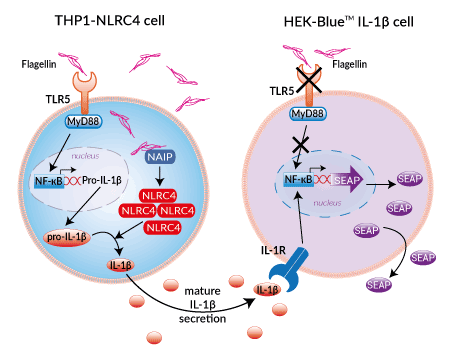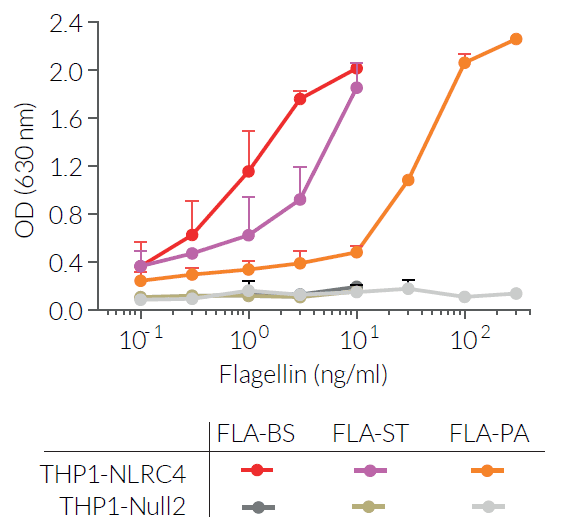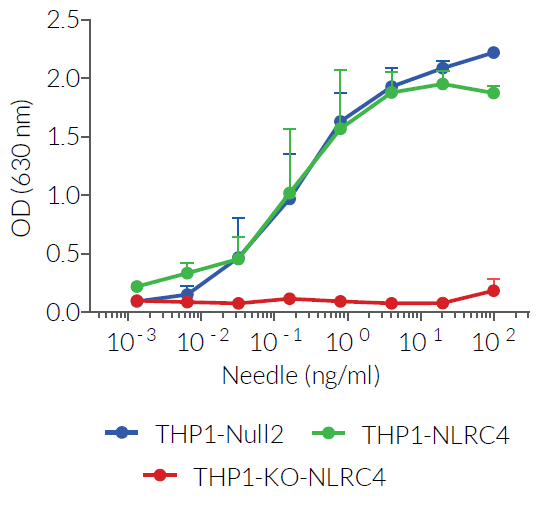NLRC4 overexpressing THP-1 Cells
| Product | Unit size | Cat. code | Docs. | Qty. | Price | |
|---|---|---|---|---|---|---|
|
THP1-NLRC4 Cells NLRC4 inflammasome test cell line |
Show product |
3-7 x 10e6 cells |
thp-nlrc4
|
|
||
|
THP1-NLRC4 vial Additional cell vial |
Show product |
3-7 x 10e6 cells |
thp-nlrc4-av
|
|||
|
HEK-Blue™ IL-1β Cells HEK 293 reporter cells for human and murine IL-1β cytokines |
Show product |
3-7 x 10e6 cells |
hkb-il1bv2
|
|||
|
HEK-Blue™ IL-1β vial Additional cell vial |
Show product |
3-7 x 10e6 cells |
hkb-il1bv2-av
|
Notification: Reference #thp-nlrc4-av can only be ordered together with reference #thp-nlrc4.
Reference #hkb-il1bv2-av can only be ordered together with reference #hkb-il1bv2.
NLRC4 inflammasome reporter assay
InvivoGen has developed a cell-based assay to monitor the activation of the NLRC4 inflammasome by intracellular flagellin. This assay relies on two cell lines:
• THP1-NLRC4 cells – Human NLRC4 overexpressing cells
• HEK-Blue™ IL-1β cells – IL-1β reporter cells
NLRC4 (Nucleotide-binding domain (NBD) and leucine-rich repeat (LRR) receptor, CARD domain-containing protein 4, or IPAF) is a cytoplasmic protein which upon activation, triggers the assembly of an NLRC4 inflammasome. IL-1β secretion and pyroptotic cell death are two major outcomes of inflammasome activation.

Principle of Flagellin-NLRC4 reporter assay
NLRC4 inflammasome test cell line
THP1-NLRC4 cells are derived from the THP-1 human monocytic cell line. They stably overexpress NLRC4 and naturally express TLR5, two pattern recognition receptors for flagellins. Thus, their incubation with flagellins triggers TLR5 activation at the cell surface and NLRC4/NAIP inflammasome assembly in the cytosol. TLR5 signaling leads to NF-κB activation and pro-IL1β expression. NLRC4/NAIP inflammasome activation leads to caspase-1-mediated maturation and secretion of IL-1β. The level of bioactive IL-1β in the supernatant can be monitored using HEK-Blue™ IL-1β cells.
Substantial flagellin amounts are required for intracellular detection by NLRC4/NAIP inflammasome in THP-1 (WT) cells. NLRC4 overexpression increases the cell line sensitivity to flagellins from various Gram-negative bacteria, without impacting the inflammasome response to highly potent NLRC4 inducers, such as LFn-Needle (see Figures).
IL-1β reporter cell line
HEK-Blue™ IL-1β cells derive from the human embryonic kidney HEK 293 cell line. They express an NF-κB/AP-1 inducible secreted embryonic alkaline phosphatase (SEAP) reporter. The binding of IL-1β to its receptor on the surface of HEK-Blue™ IL-1β cells triggers a signaling cascade leading to NF-κB/AP-1 activation and subsequent production of SEAP. Levels of SEAP can be easily monitored using QUANTI-Blue™ Solution. Importantly, the gene encoding TLR5, which also signals through the NF-κB/AP-1 pathway has been knocked out in HEK-Blue™ IL-1β cells. Thus, any flagellin remaining in the culture supernatant does not interfere with the IL-1β monitoring.
More information about HEK-Blue™ IL-1β cells.
Notes:
- The IL-1β response can also be assessed by RT-qPCR, Western blot, or ELISA. InvivoGen’s HEK-Blue™ IL-1β cells allow the detection and quantification of secreted bioactive IL-1β.
- The previously related IL-1β reporter cell line, HEK-Blue™ KD-TLR5, has been replaced by the HEK-Blue™ IL-1β cell line which is KO for TLR3, TLR5, and TNFAR. For inquiries about HEK-Blue™ KD-TLR5, please contact us.
![]() Download our Practical guide on Inflammasomes
Download our Practical guide on Inflammasomes
Specifications
THP1-NLRC4 cells
Antibiotic resistance: Blasticidin
Growth medium: RPMI 1640, 2 mM L-glutamine, 25 mM HEPES, 10% (v/v) heat-inactivated fetal bovine serum (FBS), 100 U/ml penicillin, 100 µg/ml streptomycin, 100 µg/ml Normocin™
Quality Control:
- NLRC4 expression has been verified by qRT-PCR and functional assays.
- The stability for 20 passages, following thawing, has been verified.
- These cells are guaranteed mycoplasma-free.
HEK-Blue™ IL-1β cells
Antibiotic resistance: Zeocin®
Growth medium: DMEM, 4.5 g/l glucose, 2 mM L-Glutamine, 10% (v/v) heat-inactivated fetal bovine serum, 100 U/ml penicillin, 100 µg/ml streptomycin, 100 µg/ml Normocin™
Quality control:
- SEAP reporter activity in response to IL-1β and other cytokines has been validated using functional assays.
- The stability for 20 passages, following thawing, has been verified.
- These cells are guaranteed mycoplasma-free.
Detection of human and murine IL-1β (α):
- Detection range for human IL-1β: 100 pg - 100 ng/ml
- Detection range for murine IL-1β: 10 ng - 1 µg/ml
Contents
Please note: Each cell line is sold separately. See TDS for the exact contents of each cell line.
- 3-7 x 106 THP1-NLRC4 cells in a cryovial or shipping flask
- 1 ml of Blasticidin (10 mg/ml)
-
1 ml of Normocin™ (50 mg/ml). Normocin™ is a formulation of antibiotics active against mycoplasmas, bacteria, and fungi.
- 3-7 x 106 HEK-Blue™ IL-1β cells in a cryovial or shipping flask
- 1 ml of Zeocin® (100 mg/ml)
- 1 ml of Normocin™ (50 mg/ml)
- 1 ml of QB reagent and 1 ml of QB buffer (sufficient to prepare 100 ml of QUANTI-Blue™ Solution, a SEAP detection reagent)
![]() Shipped on dry ice (Europe, USA, Canada and some areas in Asia)
Shipped on dry ice (Europe, USA, Canada and some areas in Asia)
Details
NLRC4 inflammasome background
Inflammasomes are cytoplasmic multi-protein complexes, characterized by a primary sensor, that assemble in response to infections and cellular damage. NLRC4 is an indirect sensor that must associate with NAIP (NLR family apoptosis inhibitory protein) to induce the assembly of an NLRC4 inflammasome. A single NAIP operates upstream of NLRC4 in humans and recognizes intracellular Flagellin, Needle, or Rod from several Gram-negative bacterial strains [1]. These ligands are sensed by NAIP upon bacterial invasion, or cytosolic translocation through the bacterial type III or IV secretion systems (T3SS or T4SS). Once recruited by NAIP, NLRC4 triggers a homo-polymerization through NBD-NBD interactions, allowing a CARD clustering [1]. The NLRC4 polymer further associates to pro-caspase-1, either through direct CARD-CARD interaction or through the binding of the ASC (apoptosis-associated speck-like protein) adaptor [1]. Activation of caspase-1 induces the maturation of pro-IL-1β/pro-IL-18, cleavage of the pore-forming gasdermin D (GSDMD), secretion of IL-1β/-18, and pyroptosis [1-3]. The NLRC4 inflammasome appears to protect mucosal barriers such as the lung, stomach, and intestine from invading bacteria [3]. Gain-of-function mutations have been described in human NLRC4 and are associated with auto-inflammatory conditions [3].
References:
1. Zhang L. et al., 2015. Cryo-EM structure of the activated NAIP2-NLRC4 inflammasome reveals nucleated polymerization. Science. 350:404-409.
2. Zhao Y. et al., 2011. The NLRC4 inflammasome receptors for bacterial flagellin and type III secretion apparatus. Nature. 477: 596-600.
3. Bauer R. & Rauch I., 2011. The NAIP/NLRC4 inflammasome in infection and pathology. Mol. Aspects Med. 2020 Jun 1:100863.
Back to the top








